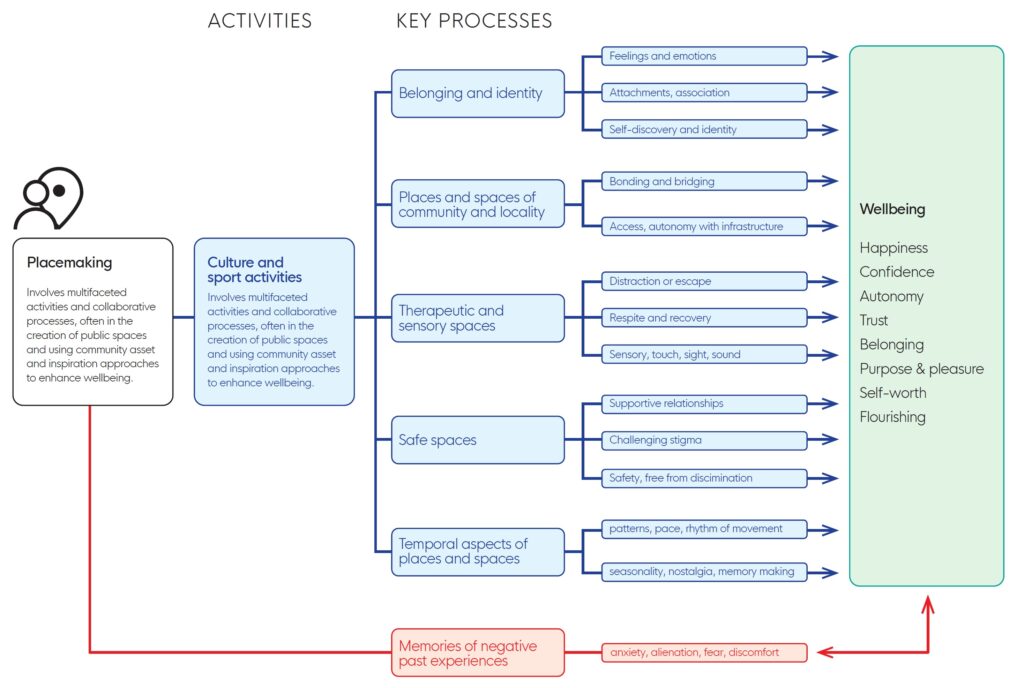Places, spaces, and loneliness: what matters for participatory art and sport?
Today we publish new evidence on why and how places and spaces can impact wellbeing and loneliness for participants of participatory arts, culture, and sports projects and programmes. This is especially timely as we look to connect socially, while physically distancing ourselves.
Things have radically changed for sport, cultural, and participatory arts organisations right now. Beyond the event and project cancellations, there is a re-thinking of what participation, community, and culture can mean for different people, and how they access it. What does making people feel welcome and included look like online? How do we ‘meet and greet’ when we can’t get close? How are we using ‘green’ and ‘blue’ spaces differently? How could use of space be made easier, for example wider, or new, paths? What signs about local features, wildlife or history could increase a sense of belonging?
The Centre’s evidence review in 2018 already shows the role of physical and social infrastructure plays in individual and community wellbeing. This review helps organisations working in new – often virtual ways – to think about how to help people come together and adapt, while maintaining physical distance. It also looks at how we can use the indoor and outdoor spaces now available to benefit people and communities.
And, in the longer-term, the review may support thinking about how places and spaces can be designed and used to foster good social connections to enhance wellbeing and alleviate loneliness.
Key findings
- Places matter to improve wellbeing and reduce loneliness. Places like parks, community hubs or museums can provide ‘safe’ spaces that reduce stigma and encourage authentic connections. The places and spaces an activity is held in, or part of, can give us a sense of meaning and identity that can impact our wellbeing.
- There is strong evidence that participatory arts, sport, and cultural activities can improve wellbeing when they:
- bring together participants with shared interests, experiences and values in the same physical spaces
- create opportunities for participants to maximise the meaning of places for themselves
- ensure inclusivity and are aware that potential divisions – such as class, gender, ethnicity, age and disability – can be reinforced through the place or space an activity is held in.
- Our attachment and connection to places can be enhanced by evoking memories for participants. This depends on the history of the place and its meaning for the person. Sensory stimulation – sights, sounds, smell, touch – plays an important role in this.
- Nature-based activities seem to be especially important to enhance the therapeutic and sensory benefits of physical activities.
- There is promising evidence on the importance of creating meaningful safe spaces for arts, sport, and cultural activities. Such safe spaces can reduce loneliness and increase wellbeing by challenging stigma and creating relationships who are free from personal criticism and harassment.
How this applies to different arts, sports, and cultural programmes looks different depending on a range of factors. But the chart below shows opportunities to ‘design in’ wellbeing into how a space is used for participatory arts, cultural activities, and sport.

What does this mean for sport, participatory art, and other cultural organisations?
The following are a set of evidence-informed prompts that organisations carrying out virtual or physically distanced activities can ask to think through the spaces and places they are using to deliver services. They can also help design wellbeing into place-based activities in the future.
Increasing belonging and identity
- How can you strengthen participants’ sense of feeling that they belong?
- How can you encourage processes of self-discovery that can be meaningful for the participants?
- How can you enable people to take ownership of a space to enhance their connection to it?
Recognising community and locality
- Have you tried to use existing spaces with groups you are less familiar with, or in a way you haven’t previously?
- How can you mitigate the negative effects of social, racial and cultural divisions, and promote learning instead?
- Do your activities encourage sharing and mutual support for those from similar and different backgrounds?
Enhancing therapeutic and sensory spaces
- How might you increase awareness about the participants’ bodily sensations in a space?
- Have you considered any nature-based sites for parts of the project, if that is appropriate for your group?
- Have you anticipated how you would deal with the space provoking any possible negative outcomes, such as remembering distressing experiences?
Creating safe spaces
- How are you making sure potential participants feel welcome, and participants feel included in relation to the spaces and places your programme is carried out in?
- How can you encourage processes of support and mutual understanding?
- Can you predict what types of social stigma may arise in your participants, and how could you mitigate this?
Being aware of pace and rhythm of spaces
- What ideas do you have for creating shared rhythms between participants in a space?
- How can your activities bring your participants into the present, yet allow them to reflect on their past?
Evidence call: volunteering and wellbeing
Share your evaluations and reports on volunteers to help inform our review of what works to improve volunteer wellbeing.
